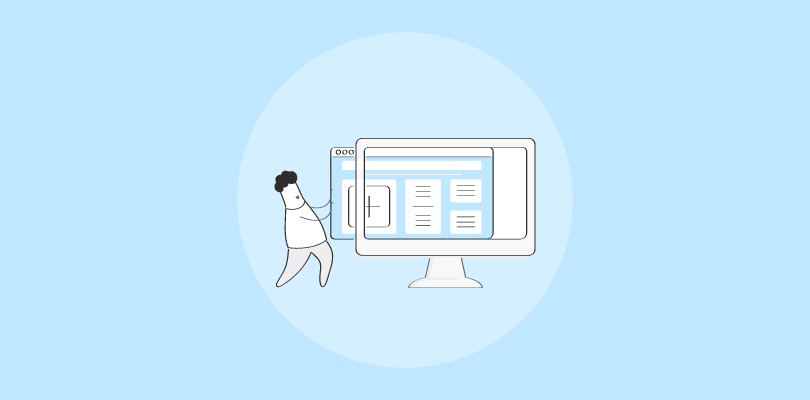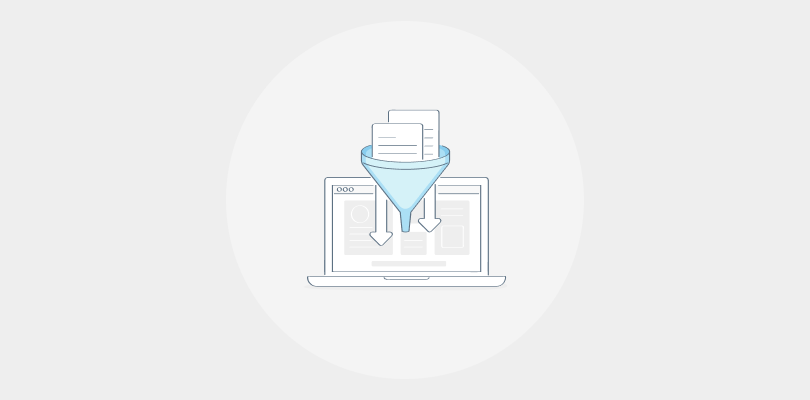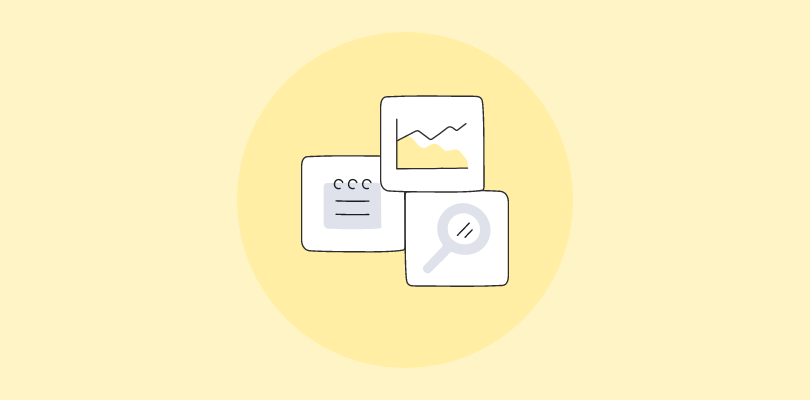Did you know that 81% of consumers say they need to trust a brand before making a purchase? That’s huge—because trust isn’t built on guesswork. It comes from truly understanding your customers, what they want, and what drives their decisions.
That’s where market research questions come in. The right questions help you learn what customers care about, what influences their choices, and how they perceive your brand.
But here’s the thing—not all questions are created equal. Vague or generic ones won’t give you much to work with. The questions need to be clear, focused, and structured to get meaningful insights to reveal actual customer preferences, pain points, and behaviors.
In this post, I’ll share 135+ market research questions to help you collect valuable insights on your target audience, competitors, product ideas, and brand perception. Let’s get started.
What Is Market Research?
Market research is how businesses learn what customers want, how competitors position themselves, and where opportunities exist in the market. Instead of making assumptions, companies use research to collect real data that guide product development, marketing strategies, and overall business growth decisions.
At its core, market research is about understanding people—what influences their choices and how they interact with products and services. When done right, it helps businesses make smarter decisions that align with customer expectations.
Importance of Market Research
Understanding your audience is the foundation of clever marketing. The right research helps you learn about customer traits, preferences, and behaviors, allowing you to design connective strategies. Without this insight, you risk targeting the wrong people, wasting efforts and higher costs.
Moreover, not every customer is worth pursuing. If you spend more to acquire them than they bring in, your profits take a hit. Instead of aiming for everyone, focus on high-value customers—those who buy repeatedly, are loyal to your brand, or have more purchasing power. Market research helps you define these segments so you can tailor your marketing and maximize conversions.
Once you know your best customers, you can refine your approach. Personalized campaigns based on customer behavior—like email offers for app downloads or location-based ads—improve engagement and drive action. Customers are more likely to respond when your messaging speaks directly to their needs.
Lastly, market research strengthens brand awareness by aligning your product with customer lifestyles and habits. Engaging with your customers through social media, responding to brand mentions, and running emotionally driven ad campaigns help create lasting impressions, turning satisfied customers into advocates.
135+ Great Market Research Questions for Your Customers
When designing and conducting research, the main challenge is, “What questions should I ask in my customer research survey?” That’s why I have a carefully curated list of market research questions to help you get started.
To Explore New Product Opportunities
Check Out More Product Opportunity Survey Templates
- What was your first reaction to the product?
- Would you purchase this product if it were available today?
- What feature would you like to see on the website/product?
- Which feature will help improve the product experience for you?
- Out of these four options, what’s the next thing you think we should build?
- Which feature can we add that would make our product
- Would implementing [this feature] increase the usability of the [product name]?
- Please let us know how we can further improve this feature.
- What problem would you like to solve with our product?
To Collect Feedback on Existing Products
- Have you heard of [product name or category] before?
- How would you feel if [product name] was no longer available?
- How disappointed would you be if you could no longer use [Product/feature name?]
- How often do you use [product name]?
- How long have you been using [product name] for?
- When was the last time you used [product name]?
- Please rate the following product features according to their importance to you.
- According to you, In which area is this product/service lacking the most? Specify below.
- How does the product run after the update?
- Rate our product based on the following aspects:
- Have you faced any problems with the product? Specify below.
- What feature did you expect but not find?
- How are you planning to use [product or service]?
- How satisfied are you with the product?
- How often do you use [product name]?
- How long have you been using [product name] for?
- When was the last time you used [product name]?
- According to you, In which area is this product/service lacking the most? Specify below.
- How does the product run after the update?
- Have you faced any problems with the product? Specify below.
- What feature did you expect but not find?
- How are you planning to use [product or service]?
- How satisfied are you with the product?
- Have you heard of [product name or category] before?
- How would you feel if [product name] was no longer available?
- How disappointed would you be if you could no longer use [Product/feature name?]
- How often do you use [product name]?
- How long have you been using [product name] for?
- When was the last time you used [product name]?
- Please rate the following product features according to their importance to you.
- According to you, In which area is this product/service lacking the most? Specify below.
- How does the product run after the update?
- Rate our product based on the following aspects:
- Have you faced any problems with the product? Specify below.
- What feature did you expect but not find?
- How are you planning to use [product or service]?
- How satisfied are you with the product?
To Segment the Target Market
- Please specify your age.
- Please specify your gender.
- Select your highest level of education.
- What is your current occupation?
- What is your monthly household income?
- What is your current marital status?
- What is the name of your company?
- Where is your company’s headquarters located?
- Please specify the number of employees that work in your company.
- What is your job title?
- In which location do you work?
- Which activity do you prefer in your free time?
- Which other physical activities do you take part in?
- Where is your dream holiday destination?
- Please rate the following as per their priority: Family, work, and social life.
- Are you happy with your current work-life balance?
- Do you describe yourself as an optimist or a pessimist?
- How often do you give to charity?
- How do you travel to work?
- How do you do your Holiday shopping?
To Conduct a Competition Analysis
- Which product/service would you consider as an alternative to ours?
- Rate our competitor based on the following:
- Have you seen any website/product/app with a similar feature?
- How would you compare our products to our competitors?
- Why did you choose to use our [product] over other options?
- Compared to our competitors, is our product quality better, worse, or about the same?
- Which other options did you consider before choosing [product name]?
- Please list the top three things that persuaded you to use us rather than a competitor.
- According to you, which brand best fits each of the following traits?
To Gauge Brand Awareness
- Have you heard of the [Your brand name] before?
- How do you feel about this brand?
- How did you hear about us?
- Describe [brand name] in one sentence.
- Would you recommend our brand to others based on its current features and attributes?
- Please tell us what you like the most about [your brand name]. If not, please specify the reason.
- How likely are you to purchase a product from this company again?
- Have you seen this brand’s advertisements? If yes, where have you seen or heard about our brand recently? (Select all that apply)
- Do you currently use the product of this brand?
- Have you purchased from this brand before?
- Do you currently use the product of this brand?
- Of all the brands offering similar products, which do you feel is the best brand?
- Please specify what makes it the best brand for you in the category.
- Which of the following products have you tried? (Select all that apply)
- On a scale of 1 to 10, how likely would you recommend this brand to a friend or colleague?
To Map Customers’ Preferences
- Have you ever boycotted a brand? If so, which brand and why?
- What influences your purchase decision more – the price or quality of the item?
- How many hours do you spend on social media like Facebook, Instagram, etc.?
- How do you do your monthly grocery shopping – online or through outlets?
- How do you search for the products you want to buy?
- Rate the factors that affect your buying decision for [product].
- What persuaded you to purchase from us?
- How likely are you to purchase a product from us again?
- Please rate the following aspects of our product based on their importance to you.
- What is the most important value our product offers to you?
- Which of the following features do you use least?
- How well does the product meet your needs?
To Map Customers’ Reservations
- Is there anything preventing you from purchasing at this point?
- What’s preventing you from starting a trial?
- Do you have any questions before you complete your purchase?
- What is the main reason you’re canceling your account?
- What are your main reasons for leaving?
- What was your biggest fear or concern about purchasing from us?
- What is the problem that the product/service helped to solve for you?
- What problems did you encounter while using our [product]?
- How easy did we make it to solve your problem?
- What is your greatest concern about [product]?
- Have you started using other similar products? If yes, what made you choose that product?
To Perform Pricing Analysis
- Would you purchase the product at [price]
- According to you, what should be the ideal price of the [product name]?
- Is our product pricing clear?
- According to you, what is the ideal price range for the product?
To Collect Feedback on Website Copy
- Please rate the website based on the following aspects:
- How well does the website meet your needs?
- Was the information easy to find?
- Was the information clearly presented?
- What other information should we provide on our website?
- How can we make the site easier to use?
- What could we do to make this site more helpful?
- Is there anything on this site that doesn’t work how you expected it to?
- How easy was it to find the information you were looking for?
- Have feedback or an idea? Leave it here!
- Help us make the product better. Please leave your feedback.
To Assess Website/Product Usability
- Are you satisfied with the website layout?
- What features are missing on our website?
- What features do you not like on our website?
- Was our website navigation simple and user-friendly?
- How much time did it take to find what you were looking for on our website?
- Was it easy to find the products you are looking for?
- Was the payment process convenient?
To Uncover Market Trends and Industry Insights
- Did you purchase our product out of peer influence or individual preference?
- How do you form your opinion about our product?
- Do you follow product trends or prefer to go with what you know?
- Do discounts or incentives impact your decision-making process?
Why Conduct Market Research & Who Should You Ask?
- Why Conduct It?
Market research isn’t just for big companies—it’s essential for any business looking to grow, stay competitive, and make smarter decisions. Here are 5 reasons why it matters:
- Understand Your Customers Better: People buy from businesses that “get” them. Market research helps you learn who your customers are, what they need, and what drives their decisions. With these insights, you can create products, services, and marketing that speak to them.
- Spot New Opportunities: Markets are constantly changing. Staying ahead of trends and customer demands helps you find gaps in the market and develop solutions before your competitors do. Whether it’s an untapped audience or a rising demand, market research helps you identify where to focus next.
- Reduce Business Risks: Launching a new product or campaign without research is like throwing darts in the dark. Market research minimizes uncertainty by giving you data-backed insights to avoid expensive mistakes and make informed decisions.
- Stay Ahead of Competitors: What are your competitors doing right? Where are they falling short? Market research lets you analyze competitors to differentiate your brand, improve your offerings, and position yourself as the better choice.
- Make Smarter Decisions: From pricing and product development to marketing and sales strategies, market research gives you the information you need to make decisions based on facts, not assumptions. The more you know, the better you can adapt and grow.
- Whom to Ask?
The right people to survey depends on what you’re trying to learn. Different groups provide different insights, so it’s important to target the right audience.
Understanding the Qualaroo Targeting section
- Your Current Customers: Your customers are the best people to ask about what’s working, what’s frustrating, and what would make them stick around longer. Their feedback helps improve customer satisfaction and retention.
- Potential Customers: To attract new buyers, you need to understand their pain points, preferences, and what’s stopping them from choosing you. Reaching out to your ideal audience—before they convert—gives you insights into how to win them over.
- Industry Experts: Sometimes, the best insights come from consultants, analysts, or thought leaders who study your industry. They can provide data on trends, competitor strategies, and emerging opportunities.
- Competitors’ Customers: Why do people choose your competitors over you? What do they like about their experience? Studying reviews, conducting surveys, or analyzing feedback from competitor customers can help you identify ways to improve and stand out.
- Your Team: Your employees—especially sales and customer service teams—interact with customers daily and hear their concerns firsthand. Their insights can highlight pain points, common complaints, and areas where your business can do better.
FREE. All Features. FOREVER!
Try our Forever FREE account with all premium features!
How to Set Clear Market Research Goals
Your market research goals should be clear, realistic, and actionable so you can actually use the insights you gather. Here are some key things businesses focus on:
- Find the Right Customers: Figure out who’s most likely to buy from you and what makes them tick.
- Understand What People Need: Learn what problems your audience faces and what solutions they’re looking for.
- Size Up the Competition: See what your competitors are doing well (or not) so you can stand out.
- Test New Ideas Before Launching: Get feedback on product concepts before investing too much time or money.
- Check Brand Awareness: Find out if people recognize your brand and what they really think about it.
- Fine-Tune Your Pricing: Make sure your pricing hits the sweet spot between value and profitability.
- Evaluate Market Potential: Know if there’s enough demand before diving into a new market or product.
- Keep Up With Industry Trends: Stay ahead of changes so your business doesn’t fall behind.
- Improve Customer Retention: Use feedback to fix what’s not working and keep customers returning.
Market Research Survey Examples
One of the easiest ways to conduct market research is to use survey templates. They can help you save time and effort in creating your own market research surveys. Many market research survey templates are available, depending on your objectives and target audience. Some of the most popular ones are:
- Demographic Templates: These templates help you segment your customers based on their location. It can help you tailor your marketing strategies and offers to different customer groups.
- Consumer Behavior Templates: These templates help you keep your pulse on your target market.
- Industry Insights Templates: These templates help you get detailed information about your target industry and business.
You can find these and more market research survey templates on Qualaroo.
Types of Market Research Questions
The answer choices in a market research survey question can significantly impact the quality and reliability of the response data you collect from the audience. Some answer types help categorize the audience, while others measure their satisfaction or agreement.
Let’s understand their types:
- Multiple Choice: A multiple-choice question type lets users select more than one answer from the given options. These questions are great for collecting multiple data sets using the same question and gauging people’s preferences, opinions, and suggestions.
- Single Choice: In a single-choice question, the respondent can select only one answer from the given options. This question type is great for:
- Segregating the users.
- Prioritizing product updates based on user consensus.
- Disqualifying irrelevant respondents by placing the question at the start of your customer research survey.
- Matrix Match: A matrix matching grid can combine multiple market research questions into one to make the survey shorter. There is only one condition – the individual questions should have the same response anchors as shown in the image below:
The questions are arranged in rows, while the answer options occupy the grid columns.
- Ranking Question: A ranking question can help map customers’ preferences and set priorities for product development. This question type asks the respondent to arrange the given options in their decreasing/increasing preference.
- Dichotomous: A dichotomous question poses a simple yes or no scenario to the respondent. These question types can help disqualify irrelevant people from the survey and categorize the users into two groups.
- Likert Scale: Likert scale market research questions can help you measure the extent of respondents’ agreement/disagreement with a given statement. The answer options are arranged from positive to negative sentiments or vice versa, with the neutral option in the middle.
- Open-Ended: Open-ended market questions let you explore the respondents’ minds without restricting their answers. This question type is followed by a blank space for the respondent to add a free-text response. You can add an open-ended question as a follow-up after the first question to explore the reasons for the customer’s previous answer.
Tools like Qualaroo offer tons of different question types for your surveys. Just pick the question and match its answer option type from the drop-down. To make it more effective, you can add branching to the survey.
How to Write Your Market Research Survey Questionnaire
It’s imperative to have a dedicated repository of market research questions for your surveys. But nothing’s better than crafting your questions. For this, you need to sit with your team and discuss what information you require from the customers. It lets you analyze and document how much data you already have in your system, which can help set the market research scope.
Here’s what you need to know before you start writing customer research survey questions to understand your audience:
- Do we understand the demographics of the new market we want to target? (Age, location, ethnicity, education, company, annual income, etc.)
- What are the locations that drive the most customers to our business? How are these locations different from others?
- What are people’s interests, preferences, and fears from our new target market? Have we addressed these situations for our current customer base?
- What are the psychographic attributes of the current customers and potential market? Are we targeting these in our campaigns?
- What are the most popular engagement channels for our customers? Which channels drive the most traffic to our website?
- Do we have enough data to perform value segmentation to separate high-value and low-value customers?
- How often do these high-value customers make a purchase?
Tips for Writing Market Research Questions
- Be clear and specific—avoid vague or overly broad questions.
- Use simple, jargon-free language that respondents can easily understand.
- Keep questions neutral to prevent bias and get honest feedback.
- Structure questions logically, flowing from general to specific topics.
- Offer balanced answer choices, ensuring respondents can express a range of opinions.
- Include an optional open-ended question to capture unexpected insights.
- Test your questions internally to spot any ambiguities before launching the survey.
How to Create a User Research Survey
FREE. All Features. FOREVER!
Try our Forever FREE account with all premium features!
How to Use Market Research Questions in Your Surveys
Whether you’re exploring customer preferences, evaluating brand perception, or testing product ideas, how you design and use your questions makes all the difference. Here’s how to make the most of them in your survey:
- Align questions with your research goals to ensure meaningful insights.
- Use a mix of multiple-choice, rating scales, and open-ended questions to get both qualitative & quantitative data.
- Keep surveys concise to maintain engagement and avoid survey fatigue.
- Target the right audience segments to gather relevant and actionable feedback.
- Time the survey appropriately, such as post-purchase or after product use, to capture fresh insights.
- Test your survey with a small group before launching to ensure clarity and effectiveness.
Market Research Real-Life Use-Cases
- Case study – How Avis increased its revenue per customer
Avis, a leading car rental company, wanted to enhance customer experience by offering helpful car add-ons like navigation systems, child seats, and insurance to customers with their booking. So, it reached out to AWA Digital to find a way to promote these products and increase sales.
AWA Digital implemented research campaigns using targeted customer research surveys to determine which add-ons were popular among the customers and why.
Using these insights, the team added an interstitial pop-up just before the booking page to show customers-relevant add-ons. This simple update dramatically increased the sales of add-on items and helped Avis generate more revenue per customer.
- Case study – How customer research drives Twilio’s operations
Twilio, a cloud communications platform, places customer discovery and research at the core of its product development strategies. It helps its teams to anticipate customer needs in a constantly changing market.
Lack of time and budget are the two biggest challenges that the company faces in its product development cycle. So, the team uses targeted market research questionnaires for a product to understand the challenges the customers face today and the ones they will face tomorrow.
With abundant ideas and no time to test them all, the feedback data from customer research surveys is used to prioritize the hypotheses for testing. This makes the process more efficient and effective in producing positive results. This data-backed approach is used across 18 different teams at Twilio to release new functionality every week and deliver optimal solutions to the clients.
- Case Study – How Canon’s campaigns generated 700% ROI
AWA Digital was tasked by Canon, one of the biggest electronics companies worldwide, to assess and increase the demand for their products in different geographies. So, the AWA team conducted a customer research survey using target market questions and discovered the following attributes about customers’ purchase behavior and reservations:
In some regions, people were reluctant to spend money on a Canon camera because they were unsure if Canon was an authoritative brand. In other regions, authority was not so important to the users. Using these insights, AWA optimized the ads campaigns’ messaging for different locations to include what consumers deemed important purchase factors.
The results?
With in-depth customer feedback, Canon generated an overall ROI of 700% in all regions using personalized campaigns to target the audience.
- Case Study – How Nike improved its brand awareness multifold
Whether you’re a sneaker enthusiast or not, you’ve likely encountered Nike’s powerful digital marketing campaigns. But beyond its iconic slogan and influencer partnerships, Nike’s success is deeply rooted in data-driven decision-making. By leveraging customer analytics, the brand has personalized user experiences, optimized marketing strategies, and fueled product innovation, strengthening its position as a global leader in sportswear.
How did they do it?
Nike uses customer data at every touchpoint—its apps, website, loyalty program, and retail stores—to gather insights on user behavior, preferences, and engagement levels. These insights inform product recommendations, advertising, and even R&D efforts, ensuring that every customer interaction feels tailored and meaningful.
Nike’s Run Club and Training Club apps track user activity and provide customized gear suggestions based on running habits, fitness goals, and past purchases. If a customer logs frequent runs, Nike may recommend a new pair of lightweight running shoes—all powered by data.
How did it impact Nike as a brand?
- Nike’s tailored experiences led to increased customer interaction across its apps and platforms.
- Personalized recommendations and targeted advertising helped Nike achieve higher conversion rates and repeat purchases.
- By using data-driven storytelling, Nike created highly engaging campaigns like “You Can’t Stop Us”, which resonated with millions worldwide.
Wrapping It Up!
When you know what your customers want, what frustrates them, and what keeps them returning, you can refine your products, marketing, and overall strategy to more effectively meet their needs.
The key is to ask the right questions at the right time.
With tools like Qualaroo, collecting feedback becomes effortless. You can make data-driven improvements without guesswork by capturing in-context responses and analyzing them with AI-powered insights. The better you understand your audience, the stronger your business will become.
Learn More About Market Research
What are the 4 P’s of market research?
The four Ps—product, price, place, and promotion—are the core elements of any marketing strategy. They represent the tools businesses use to position their products, reach the right audience, and drive sales. Think of them as the building blocks that help shape how a product is developed, priced, distributed, and marketed to customers.
What are the 3 C’s of marketing?
The 3 C’s of marketing—Customer, Competition, and Company—are the foundation of any solid strategy. It begins with understanding your customers’ needs, preferences, and behaviors so you can craft messages and products that truly resonate. Then, analyzing your competition helps you spot gaps, differentiate yourself, and find your edge. Lastly, assessing your own company’s strengths and weaknesses ensures you play to your advantage while improving where needed, keeping your marketing efforts aligned with your business goals.
FREE. All Features. FOREVER!
Try our Forever FREE account with all premium features!

 We'd love your feedback!
We'd love your feedback! Thanks for your feedback!
Thanks for your feedback!





